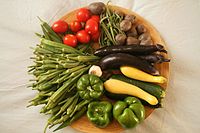
Photo from wikipedia
Abstract Objective: Subsidised or cost-offset community-supported agriculture (CO-CSA) connects farms directly to low-income households and can improve fruit and vegetable intake. This analysis identifies factors associated with participation in CO-CSA.… Click to show full abstract
Abstract Objective: Subsidised or cost-offset community-supported agriculture (CO-CSA) connects farms directly to low-income households and can improve fruit and vegetable intake. This analysis identifies factors associated with participation in CO-CSA. Design: Farm Fresh Foods for Healthy Kids (F3HK) provided a half-price, summer CO-CSA plus healthy eating classes to low-income households with children. Community characteristics (population, socio-demographics and health statistics) and CO-CSA operational practices (share sizes, pick up sites, payment options and produce selection) are described and associations with participation levels are examined. Setting: Ten communities in New York (NY), North Carolina (NC), Vermont and Washington states in USA. Participants: Caregiver–child dyads enrolled in spring 2016 or 2017. Results: Residents of micropolitan communities had more education and less poverty than in small towns. The one rural location (NC2) had the fewest college graduates (10 %) and most poverty (23 %) and poor health statistics. Most F3HK participants were white, except in NC where 45·2 % were African American. CO-CSA participation varied significantly across communities from 33 % (NC2) to 89 % (NY1) of weeks picked up. Most CO-CSA farms offered multiple share sizes (69·2 %) and participation was higher than when not offered (76·8 % v. 57·7 % of weeks); whereas 53·8 % offered a community pick up location, and participation in these communities was lower than elsewhere (64·7 % v. 78·2 % of weeks). Conclusion: CO-CSA programmes should consider offering a choice of share sizes and innovate to address potential barriers such as rural location and limited education and income among residents. Future research is needed to better understand barriers to participation, particularly among participants utilising community pick up locations.
Journal Title: Public Health Nutrition
Year Published: 2022
Link to full text (if available)
Share on Social Media: Sign Up to like & get
recommendations!